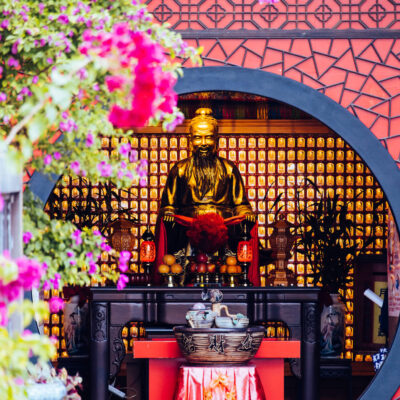In January 2025, as Donald Trump assumed the presidency of the United States for the second time, the global governance landscape began to undergo a dramatic transformation.
One of his administration’s first acts was to dismantle the U.S. Agency for International Development (USAID), a key instrument of U.S. soft power that had channelled billions of dollars to developing nations each year. Simultaneously, the U.S withdrew from the World Health Organization (WHO), the Paris Agreement on climate change, and a host of other multilateral organisations and agreements that had long underpinned international cooperation. International trade has experienced serious disruption as Trump imposed tariffs against numerous countries, allies and non-allies alike.
These moves signal a major departure from the U.S.’ decades-long role as the architect and guarantor of the post-World War II global order. The consequences have been immediate and profound: the absence of U.S. leadership has severely disrupted multilateral efforts to address some of humanity’s most pressing challenges—climate change, poverty reduction, and pandemic prevention—leaving a fragmented and disordered system in its wake.
This upheaval in global governance has thrust an urgent question into the spotlight: Can China, as the world’s second-largest economic power, step into the void and play a constructive role in establishing even a partial global order capable of tackling these critical issues?
China’s influence on global governance through the Belt and Road Initiative
China’s rise over the past few decades has positioned it as a formidable player on the world stage, with an economy that rivals that of the United States and an increasingly assertive foreign policy. The U.S. withdrawal presents both an opportunity and a challenge for Beijing, which has long sought to reform global governance to reflect its own vision. Unlike the United States, which historically promoted a liberal international order rooted in democracy and free markets, China envisions a system that prioritises state-led development, and what it refers to as recognition of diversity in civilisations—meaning that traditional values and social systems should be respected even if they differ from the liberal Western world. China has been steadily advancing this vision through a series of ambitious initiatives.
Reforming global governance has been a priority for China for well over a decade, reflecting its dissatisfaction with a Western-dominated system that it views as exclusionary and biased.
At the forefront of this effort is the Belt and Road Initiative (BRI), launched in 2013 under President Xi Jinping’s leadership. The BRI has been framed by Chinese officials as a transformative approach to global governance, one that emphasises sustainable economic development through enhanced connectivity across continents.
Supported in varying ways by over 150 countries (most notably including Pakistan, Indonesia, Argentina, Ethiopia, Saudi Arabia and U.A.E.) and international organisations—from Africa and Asia to Europe, the Middle East, Latin America, and the Caribbean—the BRI is an unprecedented infrastructure endeavour, encompassing roads, railways, ports, and power plants. By the end of 2024, China’s cumulative engagement in the BRI had reached an astonishing USD 1.175 trillion, a figure that underscores its scale and ambition. BRI funding has fluctuated, peaking in 2016, declining sharply, and then surging to a new high in 2024, with USD 70.7 billion in construction contracts and approximately USD 51 billion in investments. The financial commitment, which include aid and many state-supported investments, are not merely about building physical infrastructure; it is a strategic effort to reshape global trade routes and boost the economic development of China as well as participating nations.
The BRI’s magnitude has invited comparison with the Marshall Plan, the United States’ landmark initiative to rebuild Western Europe after World War II. Officially known as the European Recovery Program, the Marshall Plan was enacted in 1948 and provided over USD 13 billion in aid—equivalent to roughly USD 140 billion in today’s dollars—over four years. That effort was a pivotal moment in history, driving economic recovery, fostering political stability, and cementing U.S. influence in Europe during the early Cold War. The Marshall Plan’s success lay in its targeted approach, revitalising a war-ravaged region and aligning it with American geopolitical interests. By contrast, the BRI’s scope and financial commitment dwarf those of the Marshall Plan. Its investment is significantly larger than the inflation-adjusted value of the Marshall Plan, and its geographical reach extends far beyond a single continent. While the Marshall Plan was a regional project with a clear ideological agenda, the BRI is a global enterprise aimed at fostering economic integration across diverse political systems. The BRI opens new investment and trade opportunities for China, including in many nations that have limited economic ties to traditional global powers.
By constructing infrastructure such as the Gwadar Port in Pakistan, the Piraeus Port in Greece, and high-speed rail networks in Southeast Asia, the BRI facilitates global trade and promotes economic growth. For developing nations, particularly in Africa and Asia, where infrastructure deficits have long hindered progress, the BRI offers a lifeline to modernisation and connectivity.
Despite its ambitions, the impact of China’s overseas investment has been hampered by its high-risk strategy. China’s policy banks finance projects often deemed too risky by other lenders. Unlike Western multilateral banks, which prioritize rigorous risk assessments, Chinese banks offer flexible terms, sometimes at commercial rates, and accept higher credit risks to advance state-driven objectives. When loan-recipient countries face debt distress, they have to rely on additional lending or debt relief to sustain their economies. Meanwhile, China’s economic slowdown and the prolonged downturn in its real estate market have created financial pressures for both the government and the corporate sector. This is likely to constrain its external expansion in the next few years.
China’s Global Development Initiative, Global Security Initiative and Global Civilisation Initiative
Complementing the BRI’s “hardware” of large-scale infrastructure is the Global Development Initiative (GDI), launched by China in 2021 at the United Nations. The GDI is designed to accelerate the UN’s 2030 Sustainable Development Goals (SDGs), focusing on projects that directly improve people’s livelihoods—such as rural electrification, clean water systems, and agricultural training programs. While the BRI builds the physical foundations for economic connectivity, the GDI targets human-centric development, addressing poverty, education, and health in a more localised manner. Together, these initiatives reflect a dual-track approach: the BRI as the backbone of global economic integration, and the GDI as a softer, more community-focused complement. China has established a group called Friends of the GDI for regular exchange of ideas and coordination of projects, which has attracted members from over 70 countries as of July 2023, mostly from the Global South that will likely benefit from the GDI.
To implement the GDI, China has mobilised substantial financial resources. It upgraded the South-South Cooperation Assistance Fund into the Global Development and South-South Cooperation Fund, increasing its size to USD 4 billion. Additionally, China is leveraging its 2016 donation of USD 1 billion to the UN for the China-UN Peace and Development Fund, originally set to operate through 2025, with officials pledging further contributions until 2030. Beyond these funds, significant resources from Chinese financial institutions are being allocated to the GDI. A dedicated special fund of USD 10 billion has been established, with half provided by the China Development Bank (CDB)—the world’s largest development finance provider—and the other half from the Export-Import Bank of China (EXIMCH), one of the globe’s leading official export credit institutions. The Bank of China, one of the country’s “big five” state-owned commercial banks, has also committed an additional USD 2 billion, bringing the total lending pool for GDI to USD 12 billion. By the end of September 2024, more than 1,100 projects had been initiated under the GDI framework, spanning approximately 80 countries.
To further amplify the impact of GDI, the Chinese government has established a funding platform which uses government funding to leverage larger amounts of funding from private and other sources. The Gates Foundation and other private foundations, along with multilateral financial institutions such as the Asian Infrastructure Investment Bank, are actively involved in financing GDI projects. Their support helped China mobilize USD 20 billion from various sources in September 2024 for spending in the next few years.
These figures cannot fill the gap left by USAID’s retreat—over the fiscal years of 2021-2025, the average annual budgetary resources allocated to USAID were $43.1 billion. The Chinese government provides foreign aid through various channels beyond the GDI. However, officials have frequently stated that assistance will be offered in line with the country’s capacity. The Chinese government will likely continue to offer substantial aid to developing countries to strengthen South-South Cooperation amid global economic and geopolitical uncertainties. Additional funding for fiscal expansion has been raised by issuing ultra-long-term government bonds, but the use of public funds for external aid must be balanced against domestic needs, such as restructuring of local government debts and the rising costs of healthcare and pensions driven by an aging population.
In 2022, the Chinese government introduced the Global Security Initiative (GSI), advocating a security framework to address conflict and instability and craft a new narrative and principles that challenge the Western-led status quo. The GSI advocates for greater international co-operation in relation to terrorism, cybersecurity, transnational crime and other matters; and reaffirms the role of the UN, as well as other multi-lateral organisations including Chinese-led forums. Supporting countries are mostly those with good relationships with China, such as Russia, Kazakhstan, Kyrgyzstan, Uzbekistan, Nicaragua, Ecuador, and Uruguay. Although GSI has not been formally endorsed by international organisations, China has been successful in putting its core concepts into more than 90 bilateral and multilateral cooperation documents. These examples aim to demonstrate that China’s vision is a work in progress, backed by diplomatic resources and efforts.
This was followed by the Global Civilization Initiative (GCI) in March 2023, highlighting China’s dissatisfaction with the implicit treatment of Western civilization as superior to other civilizations. Together, these four initiatives—the BRI, GDI, GSI, and GCI—demonstrate China’s multifaceted strategy to reshape global governance.
In September 2023, the Chinese government released a significant policy document titled “A Global Community of Shared Future: China’s Proposals and Actions,” published in both Chinese and English to maximise its global reach. The document serves as both a manifesto and a strategic blueprint for China’s vision of a new world order.
The white paper’s release was no impromptu gesture; it built on years of rhetorical groundwork laid by President Xi Jinping, who first introduced the concept of a “community of shared future for mankind” in a 2013 speech at the Moscow State Institute of International Relations. Over the subsequent decade, this idea evolved from a diplomatic catchphrase into a comprehensive doctrine, reflecting China’s growing confidence as a global power. It aims to consolidate four initiatives under a unified narrative, positioning China as a leader capable of addressing humanity’s common challenges—climate change, poverty, conflict, and cultural division—at a moment when traditional Western-led institutions appear to be faltering.
The white paper explicitly rejects the notion that China’s rise poses a threat to other nations, a common critique in Western discourse, instead framing global challenges as shared burdens rather than an “our-country-first” mindset—a clear criticism pointing to Trump’s administration. It calls for “a new type of economic globalisation” that benefits all nations, a thinly veiled critique of Western economic hegemony. It aligns with China’s growing emphasis on South-South cooperation, under which it posits itself as the most important member of the Global South.
However, reception of the white paper and the initiatives has been mixed, reflecting the divided interests and diverse perspectives across different countries. Critics argue that the document is more propaganda than policy. Western analysts, such as those from the Council on Foreign Relations, contend that its vague language—lacking specific timelines or metrics—undermines its credibility. This criticism is also levelled at the Global Security Initiative, that is, not being specific except in relation to delegitimizing the United States and its network of alliances. But supporters, particularly in the Global South, praise its emphasis on equity and inclusivity. At the 2024 Forum on China-Africa Cooperation (FOCAC), African leaders lauded its alignment with their own development goals. The UN Secretary-General António Guterres has also expressed, on various occasions, his appreciation of China’s support for multilateralism.
China’s critique of Western hegemony alienates major powers such as the United States and European Union, which see it as a bid for Sino-centric dominance. In India, a rising power neighbouring China, economists are generally optimistic about the BRI, but there is a sense of unease within its strategic community. The Indian government has adopted a cautious and sceptical attitude towards BRI. For instance, its Ministry of External Affairs criticised the “China-Pakistan Economic Corridor”, a flagship BRI project, as violating India’s sovereignty and territorial integrity. For the same reason, Prime Minister Narendra Modi declined to endorse the BRI during the 2021 meeting of the Shanghai Cooperation Organisation summit. However, India also demonstrates pragmatism, as evidenced by its role as the second-largest shareholder of the Asian Infrastructure Investment Bank. Across the Global South, elite perspectives on China’s growing influence remain divided, with government stances often shifting in response to electoral outcomes and the need to balance economic and security relationships with the US.
How far China can go hinges on effective implementation. If China can translate its principles into concrete results—enhancing economic integration by BRI, reducing poverty through the GDI, stabilizing regions via the GSI, or fostering meaningful cultural exchange through the GCI—it could reshape global governance norms. However, China’s ambition will not be unchallenged. It will be influenced by intricate international political dynamics, especially amid disruptions from Trump’s “reciprocal tariffs” and erratic policy changes. The further the Trump administration alienates its allies, the greater China’s opportunity to advance its objectives.
Image: Lunar New Year, New York. Credit: Patrick Kwan/Wiki commons.
Further reading:
- INTERVIEW: Global China is hugely impacting the world, but ‘China’ is not a single coherent actor giving orders from the top.
- The UNDP has significantly shaped Global China’s role in international developmentThe UNDP has significantly shaped Global China’s role in international development.




